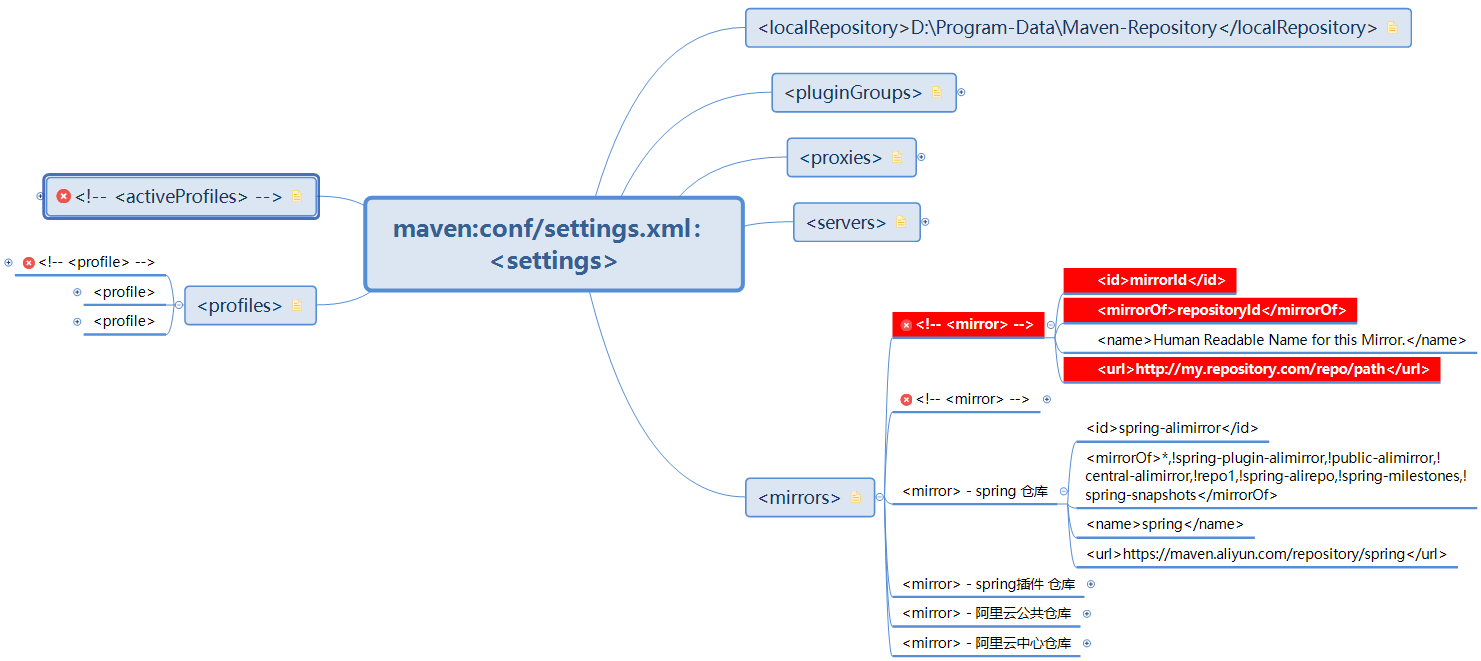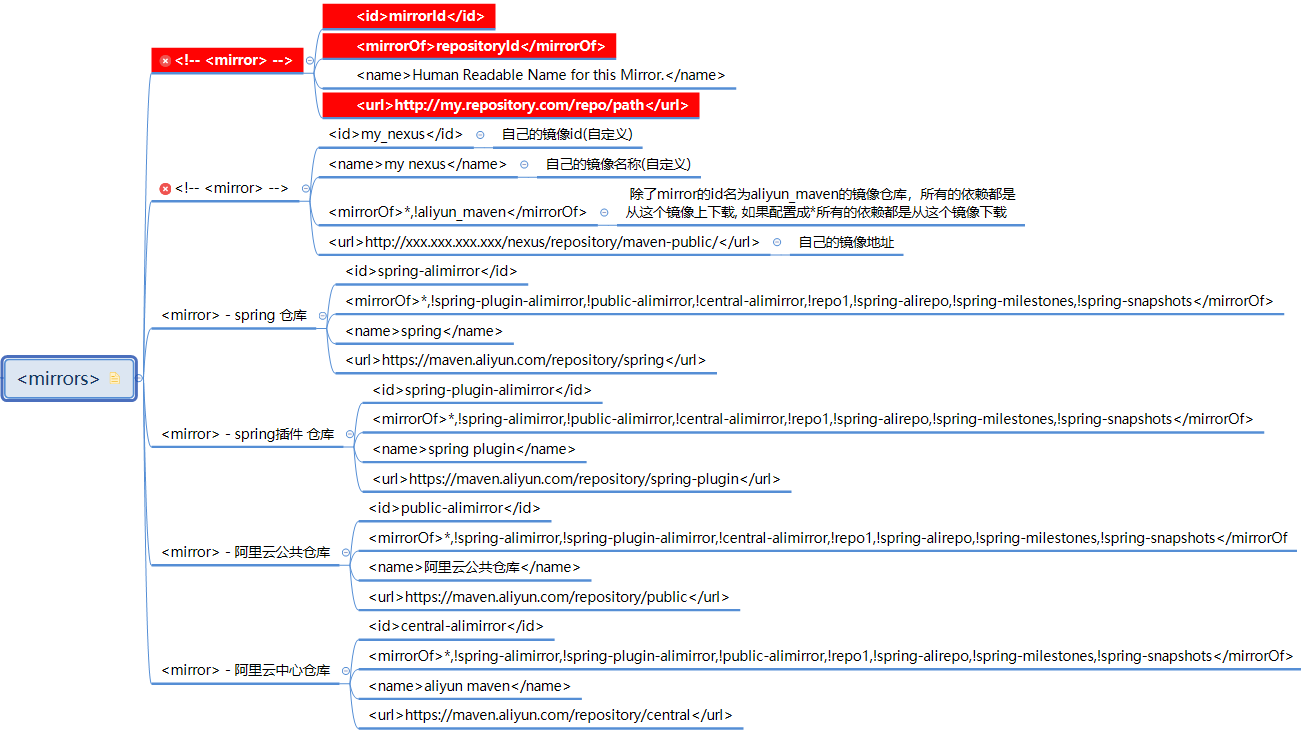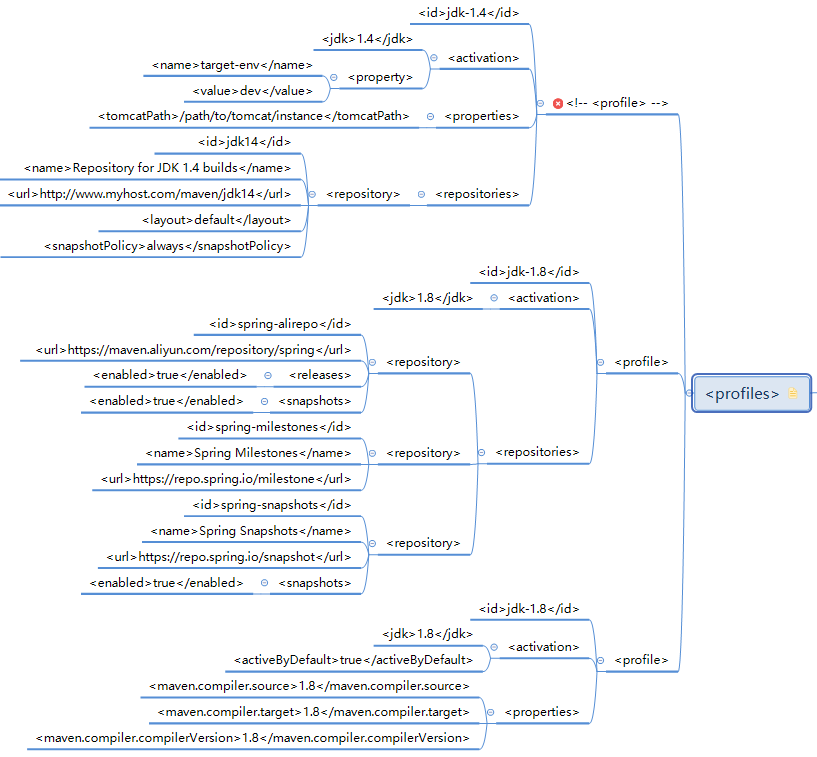[Maven]探究settings.xml
1 settings.xml的配置模块

1-1 localRepository
The path to the local repository maven will use to store artifacts.
此本地的maven仓库路径将用于存储 artifacts(项目)。
Default: ${user.home}/.m2/repository

1-2 pluginGroups
Specifies a further group identifier to use for plugin lookup.
指定一个更深一层的组标识符,以用于插件查询。

1-3 proxies
Specification for one proxy, to be used in connecting to the network.
指定用于连接到网络的一个代理。

1-4 servers
Specifies the authentication information to use when connecting to a particular server, identified by a unique name within the system (referred to by the 'id' attribute below).
指定连接到特定服务器时要使用的身份验证信息,由系统中的唯一名称标识(由下面的“id”属性引用)。
NOTE: You should either specify username/password OR privateKey/passphrase, since these pairings are used together.
注意:您应该指定 username/password 或 privateKey/passphrase,鉴于这些密码组是一起使用的。

1-5 mirrors
Specifies a repository mirror site to use instead of a given repository.
The repository that this mirror serves has an ID that matches the mirrorOf element of this mirror.
IDs are used for inheritance and direct lookup purposes, and must be unique across the set of mirrors.
指定要使用的仓库镜像站点,而不是给定的仓库。
此镜像服务的仓库具有与此镜像的mirrorOf元素匹配的ID。
id用于继承和直接查找,并且必须在整个镜像集合中是惟一的。

1-6 profiles
Specifies a set of introductions to the build process, to be activated using one or more of the mechanisms described above. For inheritance purposes, and to activate profiles via <activatedProfiles/> or the command line, profiles have to have an ID that is unique.
指定构建过程的一组介绍,使用上面描述的一种或多种机制激活。出于继承的目的,并通过或命令行激活概要文件,概要文件必须有一个惟一的ID。
An encouraged best practice for profile identification is to use a consistent naming convention for profiles, such as 'env-dev', 'env-test', 'env-production', 'user-jdcasey', 'user-brett', etc. This will make it more intuitive to understand what the set of introduced profiles is attempting to accomplish, particularly when you only have a list of profile id's for debug.
一个被鼓励的配置文件标识的最佳实践是对配置文件使用一致的命名约定,比如“env-dev”、“env-test”、“env-production”、“user-jdcasey”、“user-brett”等等。这将使您更直观地理解引入的配置文件集试图实现什么,特别是当您只有用于调试的配置文件id列表时。
This profile example uses the JDK version to trigger activation, and provides a JDK-specific repo.
这个概要文件示例使用JDK版本来触发激活,并提供了一个特定于JDK的repo。

1-7 X activeProfiles
此属性,博主未配置,故标题标记为X
List of profiles that are active for all builds.
所有构建活动的概要文件的列表。

1-8 ...
还有其它配置模块(默认: 被注释掉/不配置),暂略。
2 附: settings.xml
以下附一份自己的Maven配置文件(settings.xml),配置文件中含有详细的注释。
<?xml version="1.0" encoding="UTF-8"?>
<!--
Licensed to the Apache Software Foundation (ASF) under one
or more contributor license agreements. See the NOTICE file
distributed with this work for additional information
regarding copyright ownership. The ASF licenses this file
to you under the Apache License, Version 2.0 (the
"License"); you may not use this file except in compliance
with the License. You may obtain a copy of the License at
http://www.apache.org/licenses/LICENSE-2.0
Unless required by applicable law or agreed to in writing,
software distributed under the License is distributed on an
"AS IS" BASIS, WITHOUT WARRANTIES OR CONDITIONS OF ANY
KIND, either express or implied. See the License for the
specific language governing permissions and limitations
under the License.
-->
<!--
| This is the configuration file for Maven. It can be specified at two levels:
|
| 1. User Level. This settings.xml file provides configuration for a single user,
| and is normally provided in ${user.home}/.m2/settings.xml.
|
| NOTE: This location can be overridden with the CLI option:
|
| -s /path/to/user/settings.xml
|
| 2. Global Level. This settings.xml file provides configuration for all Maven
| users on a machine (assuming they're all using the same Maven
| installation). It's normally provided in
| ${maven.conf}/settings.xml.
|
| NOTE: This location can be overridden with the CLI option:
|
| -gs /path/to/global/settings.xml
|
| The sections in this sample file are intended to give you a running start at
| getting the most out of your Maven installation. Where appropriate, the default
| values (values used when the setting is not specified) are provided.
|
|-->
<settings xmlns="http://maven.apache.org/SETTINGS/1.0.0"
xmlns:xsi="http://www.w3.org/2001/XMLSchema-instance"
xsi:schemaLocation="http://maven.apache.org/SETTINGS/1.0.0 http://maven.apache.org/xsd/settings-1.0.0.xsd">
<!-- localRepository
| The path to the local repository maven will use to store artifacts.
|
| Default: ${user.home}/.m2/repository
<localRepository>/path/to/local/repo</localRepository>
-->
<!-- <localRepository>D:\Softwares Data\[Public Files]\MavenRepo</localRepository> -->
<localRepository>D:\Program-Data\Maven-Repository</localRepository>
<!-- interactiveMode
| This will determine whether maven prompts you when it needs input. If set to false,
| maven will use a sensible default value, perhaps based on some other setting, for
| the parameter in question.
|
| Default: true
<interactiveMode>true</interactiveMode>
-->
<!-- offline
| Determines whether maven should attempt to connect to the network when executing a build.
| This will have an effect on artifact downloads, artifact deployment, and others.
|
| Default: false
<offline>false</offline>
-->
<!-- pluginGroups
| This is a list of additional group identifiers that will be searched when resolving plugins by their prefix, i.e.
| when invoking a command line like "mvn prefix:goal". Maven will automatically add the group identifiers
| "org.apache.maven.plugins" and "org.codehaus.mojo" if these are not already contained in the list.
|-->
<pluginGroups>
<!-- pluginGroup
| Specifies a further group identifier to use for plugin lookup.
<pluginGroup>com.your.plugins</pluginGroup>
-->
</pluginGroups>
<!-- proxies
| This is a list of proxies which can be used on this machine to connect to the network.
| Unless otherwise specified (by system property or command-line switch), the first proxy
| specification in this list marked as active will be used.
|-->
<proxies>
<!-- proxy
| Specification for one proxy, to be used in connecting to the network.
|
<proxy>
<id>optional</id>
<active>true</active>
<protocol>http</protocol>
<username>proxyuser</username>
<password>proxypass</password>
<host>proxy.host.net</host>
<port>80</port>
<nonProxyHosts>local.net|some.host.com</nonProxyHosts>
</proxy>
-->
</proxies>
<!-- servers
| This is a list of authentication profiles, keyed by the server-id used within the system.
| Authentication profiles can be used whenever maven must make a connection to a remote server.
|-->
<servers>
<!-- server
| Specifies the authentication information to use when connecting to a particular server, identified by
| a unique name within the system (referred to by the 'id' attribute below).
|
| NOTE: You should either specify username/password OR privateKey/passphrase, since these pairings are
| used together.
|
<server>
<id>deploymentRepo</id>
<username>repouser</username>
<password>repopwd</password>
</server>
-->
<!-- Another sample, using keys to authenticate.
<server>
<id>siteServer</id>
<privateKey>/path/to/private/key</privateKey>
<passphrase>optional; leave empty if not used.</passphrase>
</server>
-->
</servers>
<!-- mirrors
| This is a list of mirrors to be used in downloading artifacts from remote repositories.
|
| It works like this: a POM may declare a repository to use in resolving certain artifacts.
| However, this repository may have problems with heavy traffic at times, so people have mirrored
| it to several places.
|
| That repository definition will have a unique id, so we can create a mirror reference for that
| repository, to be used as an alternate download site. The mirror site will be the preferred
| server for that repository.
|-->
<mirrors>
<!-- mirror
| Specifies a repository mirror site to use instead of a given repository. The repository that
| this mirror serves has an ID that matches the mirrorOf element of this mirror. IDs are used
| for inheritance and direct lookup purposes, and must be unique across the set of mirrors.
|
<mirror>
<id>mirrorId</id>
<mirrorOf>repositoryId</mirrorOf>
<name>Human Readable Name for this Mirror.</name>
<url>http://my.repository.com/repo/path</url>
</mirror>
-->
<!-- 自定义 Maven 的 repositories - Zhihu https://zhuanlan.zhihu.com/p/52299655 -->
<!-- 0 自己发布的镜像 -->
<!-- <mirror> -->
<!-- <id>my_nexus</id> --> <!-- 自己的镜像id(自定义) -->
<!-- <name>my nexus</name> --> <!-- 自己的镜像名称(自定义) -->
<!-- <mirrorOf>*,!aliyun_maven</mirrorOf> --> <!-- 除了mirror的id名为aliyun_maven的镜像仓库,所有的依赖都是从这个镜像上下载, 如果配置成*所有的依赖都是从这个镜像下载 -->
<!-- <url>http://xxx.xxx.xxx.xxx/nexus/repository/maven-public/</url> --> <!-- 自己的镜像地址 -->
<!-- </mirror> -->
<!-- 1 spring 仓库 -->
<mirror>
<id>spring-alimirror</id>
<mirrorOf>*,!spring-plugin-alimirror,!public-alimirror,!central-alimirror,!repo1,!spring-alirepo,!spring-milestones,!spring-snapshots</mirrorOf>
<name>spring</name>
<url>https://maven.aliyun.com/repository/spring</url>
<!-- <url>https://repo.spring.io/milestone/</url> -->
<!-- <url>https://maven.aliyun.com/repository/spring</url> -->
<!-- https://repo.spring.io/libs-milestone/ -->
</mirror>
<!-- 2 spring插件 仓库 -->
<mirror>
<id>spring-plugin-alimirror</id>
<mirrorOf>*,!spring-alimirror,!public-alimirror,!central-alimirror,!repo1,!spring-alirepo,!spring-milestones,!spring-snapshots</mirrorOf>
<name>spring plugin</name>
<url>https://maven.aliyun.com/repository/spring-plugin</url>
<!-- <url>https://repo.spring.io/snapshot/ </url> -->
<!-- <url>https://repo.spring.io/snapshot/ </url> -->
<!-- <url>https://maven.aliyun.com/repository/spring-plugin</url> -->
<!-- https://repo.spring.io/libs-milestone/ -->
</mirror>
<!-- 3 阿里云公共仓库 -->
<mirror> <!-- 阿里云官方配置(未改动) https://maven.aliyun.com/mvn/guide -->
<id>public-alimirror</id> <!-- 可自定义 -->
<mirrorOf>*,!spring-alimirror,!spring-plugin-alimirror,!central-alimirror,!repo1,!spring-alirepo,!spring-milestones,!spring-snapshots</mirrorOf><!-- 不能乱写,按需填写 -->
<!-- * -->
<!-- (根据mirrorOf和repository的id)匹配所有的库(repository) -->
<!-- 如果你需要某个jar,他会从镜像地址去下载这个jar。不管你配置了多少个库,即使这些库的地址不一样,仍然会从该镜像地址访问 -->
<!-- repo3 --> <!-- repos -->
<!--只能匹配id是repo3的库,该库会使用repo3的镜像访问。
即使还存在一个*的,这里会先查找完全相同的存储库标识符匹配的镜像。
如果找到了,就用匹配的,这里就是repo3。
如果找不到,那就去根据其他的mirrorOf查找去,查找到一个就使用。 -->
<!-- repo1,repo2,*,!repo3 -->
<!-- 完全匹配repo1,repo2和其他全部库,排除repo3库 -->
<!-- 如果存在多个重复的mirrorOf,只会用排名靠前的第一个(按照配置顺序来)。如果一个都没有,就会用maven中央库。 -->
<!-- external:* -->
<!-- 匹配本地库之外的全部库。如果本地库存在,就用本地库的。 -->
<name>阿里云公共仓库</name>
<url>https://maven.aliyun.com/repository/public</url>
</mirror>
<!-- 4 阿里云中心仓库 -->
<mirror>
<id>central-alimirror</id>
<mirrorOf>*,!spring-alimirror,!spring-plugin-alimirror,!public-alimirror,!repo1,!spring-alirepo,!spring-milestones,!spring-snapshots</mirrorOf>
<name>aliyun maven</name>
<url>https://maven.aliyun.com/repository/central</url>
<!-- <url>http://maven.aliyun.com/nexus/content/repositories/central/</url> -->
</mirror>
<!-- zt
<mirror>
<id>google-maven-central</id>
<name>Google Maven Central</name>
<url>https://maven-central.storage.googleapis.com
</url>
<mirrorOf>central</mirrorOf>
</mirror>
zt -->
<!-- 5 中央仓库1 -->
<!--<mirror>
<id>repo1</id>
<mirrorOf>central</mirrorOf>
<name>Maven Repository Switchboard</name>
<url>https://repo1.maven.org/maven2/</url>
</mirror> -->
<!-- 6 中央仓库2 -->
<!-- zt
<mirror>
<id>repo2</id>
<mirrorOf>central</mirrorOf>
<name>Human Readable Name for this Mirror.</name>
<url>http://repo2.maven.org/maven2/</url>
</mirror>
zt -->
</mirrors>
<!-- profiles
| This is a list of profiles which can be activated in a variety of ways, and which can modify
| the build process. Profiles provided in the settings.xml are intended to provide local machine-
| specific paths and repository locations which allow the build to work in the local environment.
|
| For example, if you have an integration testing plugin - like cactus - that needs to know where
| your Tomcat instance is installed, you can provide a variable here such that the variable is
| dereferenced during the build process to configure the cactus plugin.
|
| As noted above, profiles can be activated in a variety of ways. One way - the activeProfiles
| section of this document (settings.xml) - will be discussed later. Another way essentially
| relies on the detection of a system property, either matching a particular value for the property,
| or merely testing its existence. Profiles can also be activated by JDK version prefix, where a
| value of '1.4' might activate a profile when the build is executed on a JDK version of '1.4.2_07'.
| Finally, the list of active profiles can be specified directly from the command line.
|
| NOTE: For profiles defined in the settings.xml, you are restricted to specifying only artifact
| repositories, plugin repositories, and free-form properties to be used as configuration
| variables for plugins in the POM.
|
|-->
<profiles>
<!-- profile
| Specifies a set of introductions to the build process, to be activated using one or more of the
| mechanisms described above. For inheritance purposes, and to activate profiles via <activatedProfiles/>
| or the command line, profiles have to have an ID that is unique.
|
| An encouraged best practice for profile identification is to use a consistent naming convention
| for profiles, such as 'env-dev', 'env-test', 'env-production', 'user-jdcasey', 'user-brett', etc.
| This will make it more intuitive to understand what the set of introduced profiles is attempting
| to accomplish, particularly when you only have a list of profile id's for debug.
|
| This profile example uses the JDK version to trigger activation, and provides a JDK-specific repo.
<profile>
<id>jdk-1.4</id>
<activation>
<jdk>1.4</jdk>
</activation>
<repositories>
<repository>
<id>jdk14</id>
<name>Repository for JDK 1.4 builds</name>
<url>http://www.myhost.com/maven/jdk14</url>
<layout>default</layout>
<snapshotPolicy>always</snapshotPolicy>
</repository>
</repositories>
</profile>
-->
<profile>
<id>jdk-1.8</id>
<activation>
<jdk>1.8</jdk>
</activation>
<repositories>
<repository> <!-- 【配置spring代理仓库】 阿里云官方配置(未改动) https://maven.aliyun.com/mvn/guide -->
<id>spring-alirepo</id>
<url>https://maven.aliyun.com/repository/spring</url>
<releases>
<enabled>true</enabled>
</releases>
<snapshots>
<enabled>true</enabled>
</snapshots>
</repository>
<repository>
<id>spring-milestones</id>
<name>Spring Milestones</name>
<url>https://repo.spring.io/milestone</url>
</repository>
<repository>
<id>spring-snapshots</id>
<name>Spring Snapshots</name>
<url>https://repo.spring.io/snapshot</url>
<snapshots>
<enabled>true</enabled>
</snapshots>
</repository>
</repositories>
</profile>
<!--
| Here is another profile, activated by the system property 'target-env' with a value of 'dev',
| which provides a specific path to the Tomcat instance. To use this, your plugin configuration
| might hypothetically look like:
|
| ...
| <plugin>
| <groupId>org.myco.myplugins</groupId>
| <artifactId>myplugin</artifactId>
|
| <configuration>
| <tomcatLocation>${tomcatPath}</tomcatLocation>
| </configuration>
| </plugin>
| ...
|
| NOTE: If you just wanted to inject this configuration whenever someone set 'target-env' to
| anything, you could just leave off the <value/> inside the activation-property.
|
<profile>
<id>env-dev</id>
<activation>
<property>
<name>target-env</name>
<value>dev</value>
</property>
</activation>
<properties>
<tomcatPath>/path/to/tomcat/instance</tomcatPath>
</properties>
</profile>
-->
<profile>
<id>jdk-1.8</id>
<activation>
<activeByDefault>true</activeByDefault>
<jdk>1.8</jdk>
</activation>
<properties>
<maven.compiler.source>1.8</maven.compiler.source>
<maven.compiler.target>1.8</maven.compiler.target>
<maven.compiler.compilerVersion>1.8</maven.compiler.compilerVersion>
</properties>
</profile>
</profiles>
<!-- activeProfiles
| List of profiles that are active for all builds.
|
<activeProfiles>
<activeProfile>alwaysActiveProfile</activeProfile>
<activeProfile>anotherAlwaysActiveProfile</activeProfile>
</activeProfiles>
-->
</settings>
X 推荐文献
[Maven]探究settings.xml的更多相关文章
- Maven的settings.xml文件结构之mirrors
Maven的远程库提供大量构件,供Maven项目直接下载使用.对于一个Maven项目,如果没有特别声明,默认使用Maven的central库,url如下: http://repo.maven.apac ...
- Maven的settings.xml配置详解
子节点详细介绍转载:http://www.cnblogs.com/jingmoxukong/p/6050172.html?utm_source=gold_browser_extension 全局配置 ...
- Maven full settings.xml
<?xml version="1.0" encoding="UTF-8"?> <!-- Licensed to the Apache Soft ...
- maven的settings.xml详细说明
转自:http://writeblog.csdn.net/ <?xml version="1.0" encoding="UTF-8"?> <s ...
- Maven中settings.xml的配置项说明
本文部分引用自:http://haohaoxuexi.iteye.com/blog/1827778 在Maven中提供了一个settings.xml文件来定义Maven的全局环境信息.这个文件会存在于 ...
- Maven配置 settings.xml 转
https://my.oschina.net/qjx1208/blog/201085 摘要: 记录settings.xml的配置,理解mirror.repository.profile的关系 本地仓库 ...
- Maven中settings.xml的配置项说明精讲
1.Maven的配置文件(Maven的安装目录/conf/settings.xml ) 和 Maven仓库下(默认的Maven仓库的是用户家目录下的.m2文件,可以另行制定)的settings.xml ...
- [转] 分享一个快的飞起的maven的settings.xml文件
<?xml version="1.0"?> <settings> <localRepository>/home/yizhen/.m2/repos ...
- maven系列--settings.xml
安装maven,会有一份settings.xml文件,我们可以理解这份文件就是用来管理本地maven的一系列东西的.这里我先贴出一份完整的原始xml. <?xml version="1 ...
- Maven 的 settings.xml 配置中的mirror节点
maven2的setting.xml大家都知道,里面有个mirrors节点,用来配置镜像URL. mirrors可以配置多个mirror,每个mirror有id,name,url,mirrorOf属性 ...
随机推荐
- nodejs 利用URL和querystring获取get查询参数
为深入理解request的get url信息及参数传递,利用URL和querystring获取对应的信息,测试成功,记录如下: 1.编写server.js文件 http=require("h ...
- 关于 TabControl 获取 被鼠标右键的 TabPage 而编写的函数...
关于 TabControl 获取 被鼠标右键的 TabPage 而编写的函数... 功能: 1.不需考虑 SizeMode 情况 2.可以获取通过鼠标右键点击的 Tab 3.且顺便返回鼠标左键点的 T ...
- 四、用CSS制作图形以及简单动画
一.利用阴影画一个月亮 说明:画月亮,需要先画一个圆,然后利用box-shadow属性,生成阴影,再将圆的颜色变为透明即可. <html> <head></head> ...
- spacy
官方文档: https://spacy.io/api Spacy功能简介 可以用于进行分词,命名实体识别,词性识别等等,但是首先需要下载预训练模型 pip install --user spacy p ...
- How to Show/Hide a Button Using the Business Process Flow Stage
How to Show/Hide a Button Using the Business Process Flow Stage In today's blog, we'll discuss how t ...
- 将后端的application/json的格式数据类型转换成前端需要的类型格式
前提:后端返回的数据内容 但是红框的数据对于前端来说是不正确的数据 所以我感觉前端处理这个数据本身这个操作都很傻X 但是我尝试进行转换代码如下: 得到的数据: 点击查看代码 const interfa ...
- Oracle表主键作为外键都用在哪些表查询
Oracle中,如果设置了外键,删除数据时,必须将外键关联一并删除,但是如果对项目不是很熟悉时,我们无法判断到底都在哪些表中有外键关联,以下提供了一个查询的SQL,可以通过数据库查询,查找到所有的外键 ...
- idea 切换database数据库方言
在适配各种国产数据库时常常遇到存在数据库方言的情况,例如openGauss支持oracle兼容模式.. 在这种情况下,就需要在idea里对方言进行切换,否则无法执行oracle语法的sql. 1.连接 ...
- Python 跳动的小球
一.实验内容:跳动的小球游戏介绍 二.实验对象:<零基础学Python>第13章 Pygame游戏编程 实例01 用以下代码创建一个游戏弹窗: 导入pygame模块并且用init()方法初 ...
- markdown基本学习
MarkDown学习 标题(二级标题 ##) 标题 字体 加粗(**文字**) 斜体 (*文字*) 加粗+斜体 (***文字***) 废弃 (~~文字~~) 引用(>文字) 摘抄 分割线(--- ...
